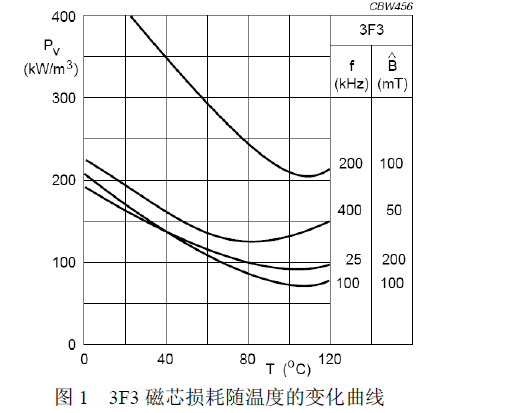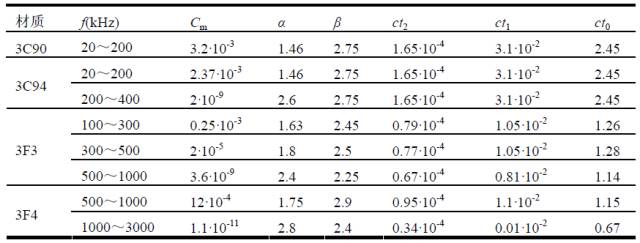I. Introduction
The magnetic component is an important component in the switching power supply device, which has a great influence on the volume and efficiency of the switching power supply device. At high frequencies, the loss of magnetic components accounts for a large proportion of the whole machine. Therefore, it is very important to conduct research on the loss of magnetic components.
Core loss is closely related to magnetic material properties and operating frequency. During AC magnetization, the core loss power (Pv) consists of hysteresis loss (Ph), eddy current loss (Pe), and residual loss (Pc). Hysteresis loss (Ph) is the energy lost by the magnetic domain during the magnetization process to overcome the friction of the magnetic domain wall. This loss eventually causes the core to heat up and be consumed. The energy loss per unit volume core is proportional to the area enclosed by the hysteresis loop. For each period of magnetization, the energy proportional to the area enclosed by the hysteresis loop is lost, so it can be concluded that the smaller the hysteresis curve area, the smaller the hysteresis loss; the higher the frequency, the greater the power loss. The eddy current loss (Pe) is due to the fact that the resistivity of the core material is not infinite, and has a certain resistance value. At high frequencies, the eddy current is generated in the magnetic core due to the excitation magnetic field. The residual loss (Pc) is a loss due to a magnetization relaxation effect or a magnetic hysteresis effect. The so-called relaxation means that in the process of magnetization or demagnetization, the magnetization state does not change to its final state immediately with the change of magnetization, but a process is required. This 'time effect' is the cause of residual loss. . In this paper, the calculation of core loss at high frequency is discussed.
Second, the classic calculation method of core lossThe composition of the core loss was analyzed. The core loss power (Pv) consists of hysteresis loss (Ph), eddy current loss (Pe) and residual loss (Pc):

For soft ferrites, the calculation model of Ph, Pe, Pc under sinusoidal waveform excitation is given in [1], but it is not suitable for engineering applications. A century ago Steinmetz summed up an empirical formula for engineering calculation of core losses:

This formula shows that the loss per unit volume Pv is an exponential function of the repetitive magnetization frequency and the magnetic flux density. Cm, α and β are empirical parameters, and both indices may not be integers, generally 1<α<3 and 2<β<3. For different materials, the manufacturer generally gives a corresponding set of parameters, but the formula and parameters are only applicable to the sinusoidal magnetization, which is a major defect in the field of switching power supply.
Third, the application and adjustment of Steinmetz's empirical formula3.1 Frequency and temperature effects
The calculation of magnetic loss by the Steinmetz model is very extensive in engineering. However, the parameters of the model vary with frequency, that is, the fitting values ​​of the power exponents α and β used to reflect the relationship between frequency and maximum magnetic induction and magnetic loss are different. The frequency is different, and the temperature has a great influence on the core loss.
Figure 1 shows the relationship between unit volume loss and temperature of 3F3 materials from Philips. Since the core loss varies with temperature, the calculation formula should consider the effect of temperature. However, there is no parameter in the formula (2) that clearly reflects the temperature influence. To this end, some manufacturers have improved on the Steinmetz empirical formula to include the effects of temperature and frequency in a more general formula. For example, the following formula is the calculation of the core loss per unit volume under the sine wave proposed by Philips. Formula (W/m3).

among them:
The parameters Cm, α, and β in equation (3) reflect the effect of frequency on core loss. The parameters ct0, ct1, ct2, and T reflect the effect of temperature, and the overall effect of temperature is represented by the parameter CT. Table 1 shows the corresponding parameters for the materials supplied by Philips. Using equations (3) and (4), the Steinmetz empirical formula (2) can be used to calculate the unit volume loss of the core material at different frequencies and temperatures for sinusoidal excitation.

Table 1 List of parameters for unit volume loss (W/m^3) of magnetic materials commonly used by Philips

3.2 Effects of non-sinusoidal excitation
Previous attempts to overcome the shortcomings of the Steinmetz model for core loss calculations under non-sinusoidal excitation by Fourier expansion of arbitrary non-sinusoidal waves, but the superposition method is only suitable for linear systems, and for nonlinear magnetic materials. In other words, it is not correct to calculate the core loss by Fourier expansion and superposition.
The Steinmetz model expressed by equation (2) proved to be the most useful tool for calculating core loss, which requires only three parameters and is generally provided by the manufacturer. For sinusoidal flux waveforms, core loss calculations using this equation can achieve higher accuracy and ease of application. It is therefore worthwhile to extend this formula to non-sinusoidal situations. To this end, Reinert proposed a modified Steinmetz empirical formula to calculate the core loss [2]. One fact that has been proven is that the macroscopic repetitive magnetization rate is directly related to the core loss. Therefore, the extended task of equation (2) is mainly to replace the frequency f in equation (2) with the physical parameter dM/dt, and dM/dt corresponds to the flux change rate dB/dt.
First, the flux change rate dB/dt is averaged over a complete magnetization cycle to obtain the following equation:

Where ΔB=Bmax-Bmin, the formula (5) can be changed to:

The literature [3] pointed out that the above formula can obtain an equivalent sinusoidal repetitive magnetization frequency feq by the conversion factor: 2/â–³BÏ€^2:

Similar to the Steinmetz empirical formula, the energy loss expression for a magnetization cycle can be derived as follows:

If the magnetization period is Tr=1/fr, the loss per unit volume (W/m^3) can be expressed as:

Equation (9) is called the modified Steinmetz empirical formula, which can be used for any non-sinusoidal magnetization waveform. Note that the parameters Cm, α and β in the formula are chosen according to feq.
3.3 Influence of DC offset
Brockmeyer [4-5] found that the loss increases with the increase of the two components by comparing the core loss under the action of the AC component BAC and the DC component BDC of different magnetic induction. At the same time, it is found that the effect of DC bias on the core loss caused by repeated magnetization can be neglected only when the repeated magnetization process does not become saturated due to DC bias, and when the AC magnetic induction is very small. Considering the influence of DC bias magnetization, Brockmeyer obtains the following empirical formula by adjusting the loss parameter Cm:

among them:

Where: K1, K2 are constants used to characterize the DC bias characteristics of magnetic materials, which can be obtained by fitting the core loss measured at different frequencies and magnetization states.
4. Current problems and future work prospectsIn the previous description, it is pointed out that core loss and temperature are closely related, and the calculation method of core loss at different temperatures is pointed out. However, in actual work, the temperature of the magnetic core cannot be known in advance. In order to accurately calculate the core loss, a thermal model of the magnetic component should be established, and the magnetic core loss calculation method and the thermal model of the magnetic component should be combined to accurately calculate the magnetic properties. Loss of components.
V. ConclusionAt present, switching power supplies are moving toward modularization and miniaturization, and the requirements for power density and efficiency are getting higher and higher. Magnetic components, as key components in switching power supplies, have a large impact on the size and efficiency of the device. Therefore, it is necessary to conduct research on the loss of magnetic components.

Receptacle Wall Plate,Electrical Outlet Covers,Electrical Outlet Cover Plates,Wall Plates For Outlets
Lishui Trimone Electrical Technology Co., Ltd , https://www.3gracegfci.com